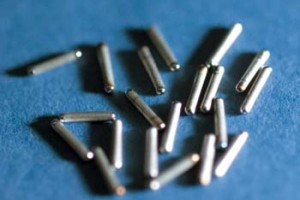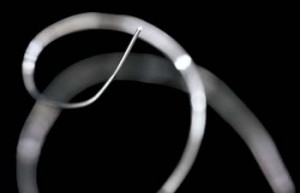
eduardo cesarIodine seedseduardo cesar
Physicist Maria Elisa Rostelato went to Buenos Aires in late June to receive an award from the American Nuclear Society, in recognition for two radioactive materials used to treat cancer that she and chemist Constância Gonçalves da Silva began developing in 1990 at Ipen, the Energy and Nuclear Research Institute. One of them, iridium-192 filaments, has been partially produced at Ipen itself since 1997. The other, iodine-125 seeds, reached the prototype stage in 2000 and should go into commercial production in 2011. Both are products for use in brachytherapy, a branch of radiotherapy. They are implanted within tumors, thus keeping healthy cells and tissues from being harmed by radiation.
Described in a scientific article in the journal Nukleonika, which led to the award for the Ipen team, the two studies began when Maria Elisa decided to listen to the physicians that were looking for domestic substitutes for radiotherapy materials that were – and that often still are – imported and expensive: in 1990, a 50 cm long iridium filament cost about US$ 1 thousand. With little data at hand, given that virtually nothing had been published, she spent two years disassembling, assembling and irradiating iridium-lined platinum filaments until she got to something that was at least equivalent to the imported filaments, which are cut into segments and implanted in arm, leg, head and neck tumors.
In 1993, Maria Elisa completed the national version’s prototype, which consists of a hollow platinum tube 0.3 mm wide and 0.2 mm thick. This external platinum layer filters undesirable radiation ranges generated by combining 20% radioactive iridium and 80% platinum, 0.1 mm thick, which fills the inside of the tube. However, she was unable to find anyone to manufacture this. The firms she contacted were only interested in making kilometers of filaments, rather than the meters that she needed. So there was no way out but to import inactive filament and radiate it at Ipen. An Ipen team under her coordination currently produces approximately 10 meters of radioactive iridium filament a year. Sold at one third the price of the imported product, the filament undergoes strict quality control to ensure that each centimeter releases always the same level of radiation.

eduardo cesarIridium filamenteduardo cesar
“If we don’t do it, no one else will,” says Maria Elisa, willing to tread the same path with the national iodine-125 seeds, which she started researching in 1998. The prototype consists of a titanium tube that is 4.5 mm long and 0.8 mm in diameter (see Pesquisa FAPESP No. 79). Actually, it is almost like a thin skin, since it is just 1mm thick. Inside it lies a silver thread, 0.5 mm in diameter and 3 mm long, covered in iodine-125.
Iodine-124 emits low-energy photons that, therefore, have limited reach, only penetrating 0.5 cm into the surrounding tissue. But this is enough to kill only the localized cells of tumors – in particular prostate tumors, one of the most common among men. This property makes it possible to implant 80 to 120 seeds per prostate, each costing US$ 34, a treatment that has several benefits, such as reducing to 25% the probability of sexual impotence, which is close to 80% when men undergo prostate removal surgery.
“I showed that we are able to make iodine seeds without having to pay royalties,” says Maria Elisa. Regarding the iridium filaments, she faced a number of setbacks in the setting-up of the production laboratory, due to go on-stream by the end of the year, by which time the soldering of the titanium tubes should have been automated, as to date it is done manually. As currently Ipen itself imports some 3,500 iodine seeds a month and transfers them to hospitals throughout Brazil, she believes that demand might reach 8,500 seeds year, if the price were lower.
Maria Elisa is bothered by the delays imposed by bureaucracy, by the importation difficulties and by the shortage of funds. “We’re in 2009 and we still haven’t managed to make the radioactive seeds,” she says. “In 2000 we were the third country to have a prototype. Today, at least five countries already make the seeds.” The start-up of the commercial production of the iridium filaments was three years late relative to the original schedule.
The project
Development of the iodine-125 seeds production technique for use in brachytherapy (01/04768-3); Type Regular Line of Research Project Aid; Coordinator Constância Gonçalves da Silva – Ipen; Investment
R$ 815,130.27